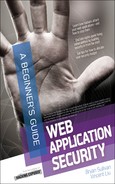Book Description
Security Smarts for the Self-Guided IT Professional
Secure web application from today's most devious hackers. Web Application Security: A Beginner's Guide helps you stock your security toolkit, prevent common hacks, and defend quickly against malicious attacks.
This practical resource includes chapters on authentication, authorization, and session management, along with browser, database, and file security--all supported by true stories from industry. You'll also get best practices for vulnerability detection and secure development, as well as a chapter that covers essential security fundamentals. This book's templates, checklists, and examples are designed to help you get started right away.
Web Application Security: A Beginner's Guide features:
• Lingo--Common security terms defined so that you're in the know on the job
• IMHO--Frank and relevant opinions based on the authors' years of industry experience
• Budget Note--Tips for getting security technologies and processes into your organization's budget
• In Actual Practice--Exceptions to the rules of security explained in real-world contexts
• Your Plan--Customizable checklists you can use on the job now
• Into Action--Tips on how, why, and when to apply new skills and techniques at work
Bryan Sullivan is a senior security researcher at Adobe Systems, where he focuses on web and cloud security issues. He was previously a security program manager on the Microsoft Security Development Lifecycle team and a development manager at HP, where he helped to design HP's vulnerability scanning tools, Webinspect and Devinspect.
Vincent Liu, CISSP, is a managing partner at Stach & Liu. He previously led the Attack & Penetration and Reverse Engineering teams for Honeywell's Global Security group and was an analyst at the National Security Agency. Vincent is a coauthor of Hacking Exposed: Web Applications, Third Edition and Hacking Exposed Wireless, Second Edition.
Table of Contents
- Title Page
- Copyright Page
- Dedication
- About the Authors
- Contents at a Glance
- Contents
- Acknowledgments
- Introduction
- PART I Primer
- PART II Web Application Security Principles
- PART III Secure Development and Deployment
- EPILOGUE The Wizard, the Giant, and the Magic Fruit Trees: A Happy Ending
- Index
